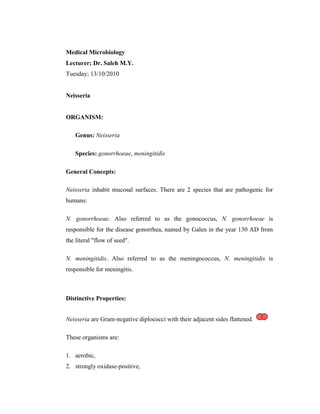
Bacteriology neisseria
- 1. Medical Microbiology<br />Lecturer; Dr. Saleh M.Y.<br />Tuesday; 13/10/2010<br />Neisseria<br />ORGANISM: <br />Genus: Neisseria <br />Species: gonorrhoeae, meningitidis <br />General Concepts: <br />Neisseria inhabit mucosal surfaces. There are 2 species that are pathogenic for humans: <br />N. gonorrhoeae. Also referred to as the gonococcus, N. gonorrhoeae is responsible for the disease gonorrhea, named by Galen in the year 130 AD from the literal quot; flow of seedquot; . <br />N. meningitidis. Also referred to as the meningococcus, N. meningitidis is responsible for meningitis.<br />Distinctive Properties: <br />Neisseria are Gram-negative diplococci with their adjacent sides flattened. <br />These organisms are: <br />aerobic, <br />strongly oxidase-positive, <br />have an oxidative metabolism, <br />susceptible to drying <br />fastidious (growth is inhibited by free fatty acids) <br />There are four types of N. gonorrhoeae based on the presence of fimbriae; T1, T2, T3 and T4. <br />N. meningitidis is serotyped by the antigenic character of its capsular polysaccharide; several groups including A, B, C, 29E, W-135 and Y are recognized. <br />Pathogenesis: <br />Gonorrhea is a sexually transmitted disease. The sites of infection include the urethra (in men) and the cervix (in women). <br />Fimbriae (pili) are very important for the gonococcus to attach to host cells. N. gonorrhoeae lacking fimbriae are avirulent (not virulent). <br />A substance called Protein I makes up 66% of the outer membrane protein of N. gonorrhoeae. This protein is antigenic and is used as the basis of some serological tests. <br />N. gonorrhoeae produce cytotoxic substances that damage ciliated epithelial cells in fallopian tubes; the LPS endotoxin may be partly responsible. <br />N. gonorrhoeae also produce an extracellular protease that cleaves a proline-threonine bond in immunoglobulin IgA. This causes loss of antibody activity. <br />Approximately 9-15% of affected women contract Pelvic Inflammatory Disease (PID) as a consequence of gonorrhea. This is often a polymicrobic infection involving Bacteroides and other anaerobes. <br />The virulence of N. meningitidis is associated with its antiphagocytic capsule. <br />The meningococcal LPS is as toxic as Escherichia or Salmonella and causes suppression of leukotriene B4 (a chemokinetic/chemotactic factor) synthesis in PMNs. <br />Untreated, meningococcal meningitis has a mortality (death) approaching 85%. <br />N. meningitidis produces proline-threonine and proline-serine proteases, but any particular isolate will only produce one or the other. <br />Host Defenses: <br />Gonorrhea: Infection stimulates local immunity (secretory Igs may enhance association with PMNs). Uncomplicated infection activates complement via the classical pathway while disseminated infections activate complement via the alternate pathway. <br />Meningitis: Anti-capsular antibodies are bactericidal. <br />Epidemiology: <br />N. gonorrhoeae normally colonizes mucosal surfaces. Humans are the only host and transmission is via sexual contact. The probability of acquiring disease from a single exposure varies: <br />in men, the probability is about 25%; <br />in women, the probability is about 40%; <br />in women taking oral contraceptives, the probability is about 100%. <br />Gonorrhea occurs worldwide and generally affects persons aged 15-29. <br />N. meningitidis inhabits the human nasopharynx. There is a 3-30% normal carrier state lasting days to months that provides the reservoir for infection of susceptible persons. Attack rates are highest in children (usually less than one year old) and sporadic epidemics do occur. <br />Diagnosis: <br />Clinical: The symptoms of gonorrhea differ between the sexes. <br />In men, a copious urethral exudate containing Gram- negative diplococci is common; <br />in women, disease is often asymptomatic. <br />The symptoms of meningitis usually begin abruptly with headache and fever. <br />However, confirmation of meningococcal infection requires bacteriologic culture. <br />Laboratory: Neisseria may be cultured on Thayer-Martin agar or other suitable media with incubation in 10% CO2.<br />Neisseria are strongly oxidase-positive, <br />Gram-negative diplococci. <br />N. gonorrhoeae oxidizes glucose only; <br />N. meningitidis oxidizes both glucose and maltose. <br />Control: <br />Sanitary: By avoiding contact with infected persons can prevent meningitis. <br />Immunological: Only experimental vaccines are available. These vaccines target the meningococcal capsular polysaccharide but are not effective against group B (the most common isolate) because of its poor immunogenicity. <br />Chemotherapeutic: Penicillin is the drug of choice for treating gonorrhea. However, the number of resistant isolates continues to increase and other drugs must be employed in these cases. Penicillin is also the drug of choice for treating meningococcal meningitis. <br />
